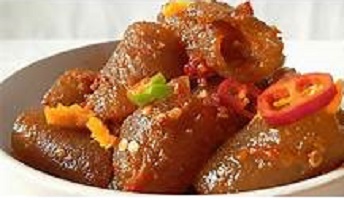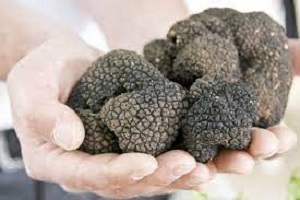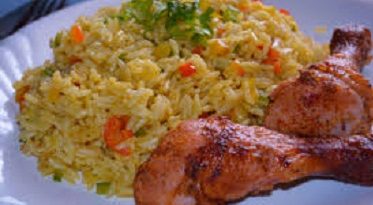Peppered Kpomo Recipe – Nigerian Cow Skin (Ponmo) Appetizer
Peppered kpomo recipe or Peppered ponmo or cow skin whatever you call it, all mean the same thing.
Peppered kpomo Recipe is a popular dish served in most Nigerian bars; this hot, spicy, and soft Ponmo sauce combines well with a bottle of drink.

Peppered ponmo is not left out during Nigerian parties and events; some serve it as small chops or as an addition to the main dish.
Related >>> Cow Skin: Solid Truth about Eating Cow Skin (Pomo)
If you’re not Nigerian and are curious about what Kpomo is like, let me help direct you a little bit.
Peppered Kpomo Recipe
If you are not Nigerian and are curious what in the world is Kpomo? Let me guide you a little bit.
But, essentially, instead of using it to make bags and shoes, we eat it. Got it? No? Ok
Cow skin is known as Kpomo. In order to remove all the hair, the skin of the cow is burned and Nigerians use the cow skin to cook stews, soups, and appetizers.
Peppered Kpomo recipe or Pomo is a mouthwatering and appetizing spicy dish also refers to as kanda meat.
Cow skin is also referred to as kanda meat.
We also have the stew Kpomo alongside the peppered ponmo Alata, which is equally delicious.
There are two variants of the Nigerian Kpomo, the thin and the soft kind we have. Kpomo English name is Cow skin, which is an edible cowhide.
Peppered Kpomo Recipe – What is Nigerian Pomo Food?
Pomo is simply pure cow skin that has been processed for people to cook and chew like meat.
As long as the cow is slaughtered for beef every day, there is bound to be cow skin that is the kpomo meat we’re talking about.
When clasped against the upper and lower teeth, Kpomo has this sweet, dense, but loose feel that’s so delicious you’ll always want more.
Visualize mixing and lubricating it with a little bit of sauce, spice, and seasonings, making it taste even better.
Thus, why won’t you rather begin your meal with a bowl of this tasty delicacy instead?
Peppered Kpomo Recipe – Harmful Or Healthy?
‘’Kpomo” or “Kanda” (or whatever name you call this common, processed cowhide and skin eaten as “meat”) has a lot of stories around it, particularly because there has not been a lot of research done on it.
Still, let’s come up with some basic details.
It’s not correct to say “kpomo” has NO nutritional value! Instead is better to say it has LOW nutritional value when compared to other food sources.
When likened to regular meats, it has low protein and skin-collagen. Other nutrients are also low.
However, it contains high dietary roughage—it helps the process of digestion quite well.
In summary, the kpomo nutrients are very low (apart from supplementing them during cooking).
What is the Health Benefit of Kpomo?
Kpomo is said to be rich in collagen – which a type of protein that aids in holding bones and skin tissues together.
How to make Nigerian Peppered Kpomo
With as little as kpomo, pepper, onion, and a few other seasonings, you will be munching in a plate of this Nigerian appetizer.
This is an easy recipe to copy and it doesn’t take time.
Recipe for Nigerian Peppered Kpomo Ingredients
- 1 kg Pomo (cow skin)
- 4 medium-size tomatoes
- ½ cup scotches bonnet pepper (Ata-rodo)
- 1 large onion
- ½ teaspoon curry powder
- ¼ cup vegetable oil
- 2 seasoning cubes
- Salt to taste
Method
- Firstly, wash your ponmo very well to be free from sand, then transfer to a clean pot set aside ready for cooking.
- Secondly, spice the Kpomo/Ponmo/kanda meat with salt, 1 seasoning cube, ½ onions slice, curry powder, and cook to tender. Then, remove from heat and drain the stock.
- Thirdly, Wash and rough grind the pepper, onion, and tomato. This recipe requires a chunky blend not smooth.
- Fourthly, in a pot or frying pan bring the oil to heat; pour in the ground pepper and onions, stir fry for about 5 minutes.
- After that, pour the cooked ponmo into the pepper stew and mix properly as it fries on the stovetop, add the remaining seasoning cube, and taste for salt. Continue to stir for like 3 minutes.
- Lastly, remove from heat, at this point your delicious peppered Kpomo is ready.
Serve with a cold drink or as a side dish to a meal (fried yam), and enjoy!
Cow skin
Cow skin, commonly known as beef tripe, is the edible lining from the stomach of cattle. While it may not be as popular as other cuts of meat, it is consumed in various cuisines around the world.
Here are some potential benefits of cow skin meat:
Rich in Protein:
Like other meat products, cow skin is a good source of high-quality protein. Protein is essential for building and repairing tissues, supporting immune function, and maintaining overall health.
Collagen Content:
Cow skin is rich in collagen, a structural protein that is crucial for maintaining the health of skin, joints, and connective tissues. Collagen is also known to promote skin elasticity and joint flexibility.
Nutrient Density:
Cow skin contains various nutrients, including vitamins and minerals such as iron, zinc, and B vitamins. These nutrients play important roles in various bodily functions, including energy metabolism, immune function, and blood formation.
Potential for Gelatin Production:
Cow skin can be processed to produce gelatin, a substance with various culinary uses. Gelatin is often used in desserts, soups, and various food products. It may also have some health benefits, such as supporting joint health and improving skin condition.
Cultural and Culinary Diversity:
In many cultures, cow skin is used in traditional dishes, adding diversity to the culinary landscape. The preparation and consumption of tripe vary widely, and it is often included in stews, soups, or grilled dishes.
It’s important to note that while cow skin can offer nutritional benefits, it may not be suitable for everyone. Some people may find the taste, texture, or odor unappealing.
Additionally, individuals with certain dietary restrictions or health conditions may need to be cautious about consuming certain animal products.
As with any food, moderation is key, and it’s essential to consider individual preferences and dietary needs.
If you have specific dietary concerns or health conditions, it’s advisable to consult with a healthcare professional or a registered dietitian for personalized advice.
What nutritional benefits does cow skin meat offer?
Cow skin meat, also known as beef tripe, is rich in high-quality protein, essential for tissue repair and immune function. It contains collagen, promoting skin and joint health, and provides essential vitamins and minerals such as iron, zinc, and B vitamins.
How does the collagen in cow skin meat contribute to health?
Collagen is a structural protein found in cow skin meat that supports skin elasticity, joint flexibility, and connective tissue health. Consuming collagen may contribute to improved skin and joint health.
Are there any specific nutrients in cow skin meat that are noteworthy?
Yes, besides protein and collagen, cow skin meat contains essential nutrients like iron, which is important for blood formation, and zinc and B vitamins that play roles in various bodily functions, including metabolism and immune support.
Can cow skin meat be beneficial for those looking to boost their protein intake?
Absolutely. Cow skin meat is a good source of protein, making it a valuable addition to a diet aiming to meet protein needs. Protein is crucial for muscle maintenance, repair, and overall body function.
Are there culinary uses for cow skin meat?
Yes, cow skin meat is used in various traditional dishes around the world. It can be included in stews, soups, or grilled dishes, adding cultural diversity to culinary practices.
What precautions should individuals take when consuming cow skin meat?
While cow skin meat has nutritional benefits, individual preferences and dietary restrictions should be considered. Some people may find its taste or texture unappealing, and individuals with dietary restrictions or health conditions should consult healthcare professionals for personalized advice.
Can cow skin meat be processed into other products with health benefits?
Yes, cow skin can be processed to produce gelatin. Gelatin has culinary uses and may offer benefits such as supporting joint health and improving skin condition.
How should cow skin meat be included in a balanced diet?
Cow skin meat can be part of a balanced diet when consumed in moderation. It can be prepared in various ways, ensuring a diverse and nutrient-rich approach to overall nutrition.
Remember, individual dietary needs vary, and it’s advisable to consult with healthcare professionals or dietitians for personalized advice based on specific health conditions or concerns.


